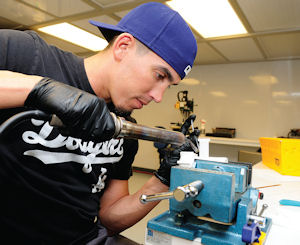A 10-liter stainless steel bottle used by pharmaceutical companies in the drug-making process can cost upward of $3,000. Now, compare that to the same size bottle made of molded plastic by Camarillo manufacturer Sani-Tech West Inc. The cost? A mere $150, cheap enough to be thrown away after one use given the big money involved in making pharmaceuticals. After years of using metal components, some pharmaceutical and biotech companies now are introducing such parts into their manufacturing processes, a move that is putting firms like Sani-Tech on a growth trajectory. This transition has been a boon for the company, which earlier this year moved to larger quarters in Camarillo from Oxnard and is looking to add employees. Single-use components not only cost less but eliminate the expense and time of cleaning stainless steel equipment, which in turn can speed up the drug-making process, said Richard Shor, Sani-Tech’s founder and president. “The turnover is quicker and they can get to their next manufacturing run,” Shor said. “We have used our know–how to replace a lot of these things.” Adoption of single-use is gaining traction worldwide. Irish pharmaceutical firm Shire Plc operates in Lexington, Mass. the first commercially licensed facility using single-use bioreactors, devices that grow cell or tissue cultures. And in August, Parker Hannifin, a Cleveland company, announced its acquisition of Middleton, Wis. pharmaceutical-device manufacturer SciLog Inc. to support its becoming a supplier to the single-use market. Locally, PBS Biotech Inc., also in Camarillo, makes single-use bioreactors used in the production of drugs and other biological based products. Brian Lee, its chief executive, said there is plenty of room for both area companies. “In general (Sani-Tech’s products) can be complimentary and we can grow together as the disposable market grows,” he said. Yet there remain skeptics in the industry not ready to embrace plastic because of multiple concerns, the chief of which is its durability. There also are worries over sterility, the potential leaching of plastic chemicals into drugs and the waste created by disposing parts, said Jeff Odum, biotech sector leader with Integrated Project Services, a Lafayetteville, Pa. engineering and consulting firm. “You can poke a hole in a bag,” Odum said. “You don’t have to worry about holes in a stainless steel tank.” Disposable bioreactor Shor founded Sani-Tech in 1991 after having worked in his family’s wholesale jewelry business and later as a salesman of plumbing supplies to the food and beverage industries, which Sani-Tech still serves. The company designs, manufactures and assembles hoses, clamps, tubing, bottles, valves and other parts. SaniSure Inc., a subsidiary, distributes components made by both Sani-Tech and other manufacturers. Sani-Tech entered the pharmaceutical single-use market in 2004 when it developed a bioreactor for CancerVax, a pharmaceutical company in Marina Del Rey. CancerVax’s drugs never got developed and the company later merged with another drug maker. But Sani-Tech realized the potential. “It’s (now) a full blown part of the business,” Shor said. Producing high-grade plastic components is not a simple business. For example, to manufacture a cell culture bottle, Sani-Tech will purchase plastic conical flasks from an outside supplier. Workers then insert plastic valves around the outside of the bottle so samples of the liquid inside can be taken without opening the top and risking contamination. To cut hoses used in connecting tanks, a special saw without any teeth is used on short lengths; for longer lengths, an operator works a hydraulic saw. The hoses are dunked in a test tank filled with water to check for leaks. The final stage for all the equipment shipped out is a clean room where gowned and masked employees wipe the pieces down and place them into bags that are sealed. Every step in the drug-making process can use single-use equipment – from hoses that transfer cell cultures from a large vat into a bioreactor, to filters that concentrate proteins, to bottles used for storage or transferring cultures. And despite the concerns some have over plastic components, biotech consultant Odum said there are companies eager to incorporate single-use into the manufacturing process. “We are doing work with a number of clients who are developing schemes for the factory of the future where the goal is to implement (single-use) from beginning to end,” he said. Smaller batches Demand for these parts is driven by a shift in business models at pharmaceutical companies, said Kevin D. Ott, executive director of the Bio-Process Systems Alliance, a Washington, D.C. trade organization that promotes the benefits of single-use systems. The age of the blockbuster drug is ending and drug makers are transitioning to specialized drugs made in smaller batches. And at the R&D stage, scientists don’t want to have to wait the days or weeks it takes to clean and validate stainless steel equipment. “You need a flexible manufacturing schedule to plug in components at a much faster rate,” Ott said. Still, it’s hard to gauge how quickly companies are adopting the use of disposable components because the drug manufacturers are reluctant to provide data. However, interest in the niche market is growing, as evidenced by a growing number of large pharmaceutical companies joining the Bio-Process alliance, or contacting it for more information, Ott said. Merck & Co., Biogen Idec, Catalent, and GlaxoSmithKline plc are members. To handle such demand, Shor expects in the next eight months to add 10 employees for quality assurance and assembly positions. That will enable Sani-Tech to add a split shift and grow 15 percent. Shor also is pursuing acquisition targets and complementary companies to form strategic alliances. The targets are smaller companies that have developed product but have not properly commercialized and marketed it. “We are always adding component to our shopping list,” he said
